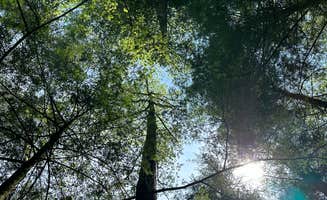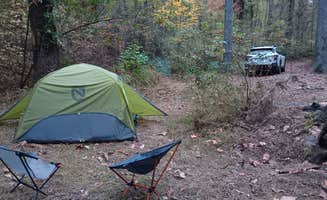Dispersed camping sites near Suwanee, Georgia range from 60 to 95 miles north in the Chattahoochee National Forest. The region features elevations between 1,800 and 4,500 feet with temperature variations of 10-15 degrees cooler at higher elevations compared to Suwanee. Most camping areas sit along Forest Service roads with varied accessibility depending on recent weather conditions.
What to do
Creek exploration: Visit Justus Creek Campsite where the water provides natural recreation. "The creek was absolutely freezing cold in July, it was great to rinse some clothes and ourselves off," notes camper Maria A., who adds it was "definitely one of our best nights sleep listening to the water."
Waterfall hunting: Multiple cascades dot the region with varying degrees of accessibility. At Helton Creek Falls Camp, visitors can explore both upper and lower falls within a short walking distance from the parking area. The lower falls create a natural pool suitable for wading during warmer months.
Mountain hiking: The area provides connections to numerous trail systems beyond the Appalachian Trail. Each summit campsite offers distinct terrain and views. Experienced hikers can find secluded spots above 3,500 feet with sunrise vantage points during clear weather conditions.
What campers like
Natural isolation: The remote settings provide genuine wilderness experiences. Campers at Preacher's Rock appreciate the elevated location despite the hike required. "Hay como 3 sitios para casas de campaña pequeñas. Es en la cima de una montaña, la subida son unos 40 minutos, al final se vuelve más exigente si lleva mochila grande," reports Ernesto H.
Creek sounds: Water features create natural white noise that enhances the camping experience. The streams run year-round with seasonal variations in water level and temperature. Many sites allow tents to be positioned within hearing distance of running water.
Accessibility options: Dicks Creek Falls Campsites offer varying degrees of seclusion. According to Lacy S., "They have a couple closer to water but most are more remote. There is a 3 mile long dirt road to travel on." This allows campers to choose their preferred balance of convenience and solitude.
What you should know
Limited facilities: Pack accordingly for rustic camping near Suwanee, Georgia. None of the dispersed sites provide drinking water, toilets, or trash service. Some areas have vault toilets at trailheads but not at actual campsites.
Water planning: Natural sources require treatment before consumption. Streams may dry up in late summer at higher elevations, requiring additional water carrying. During heavy rain periods, crossing points can become challenging.
Wildlife awareness: Bear activity varies by season and location. At Cowrock Mountain, hikers regularly encounter wildlife. Clay A. notes the practical water situation: "There is a water source about .5 miles west on the AT at Baggs Creek Gap or ~1.5 miles east at Hogpen Gap."
Access challenges: Many roads become difficult after rainfall. Four-wheel drive vehicles provide better access during wet conditions. Some campsites require navigating narrow forest roads with limited turnaround options.
Tips for camping with families
Water-centric sites: Choose locations with safe wading areas for children. At Jones Creek Dispersed Campground, Billie P. reports, "This river is amazing, low current makes its easy to walk in and there are a few little water falls we enjoyed hanging on for a bit."
Elevation consideration: Higher elevation sites provide cooler temperatures during summer months but require more preparation. Lower elevation creek-side sites offer easier access but fill quickly during peak seasons.
Distance planning: When camping with children, consider sites closer to road access. Some areas require substantial hiking with gear, which can challenge younger campers. Sites near road access points tend to receive more day visitors.
Timing strategy: Weekday arrivals significantly improve site selection opportunities. School breaks and holidays see dramatically increased usage with limited overflow options. Early summer provides optimal conditions before increased humidity and insect activity of late summer.
Tips from RVers
Clearance requirements: Forest roads to dispersed camping areas often have low-hanging branches and uneven surfaces. Most sites cannot accommodate RVs larger than 25 feet in length due to limited turning space.
Leveling challenges: Few sites provide naturally level parking. Bring additional leveling equipment as the terrain throughout the camping areas features significant slopes. Most accessible RV spots are taken by Friday afternoon during peak season.
Road intelligence: Hightower Gap Camp and similar locations require advance planning. Contact the Chattahoochee National Forest ranger station for current road conditions before attempting access with larger vehicles. Recent weather events can significantly impact road quality.



